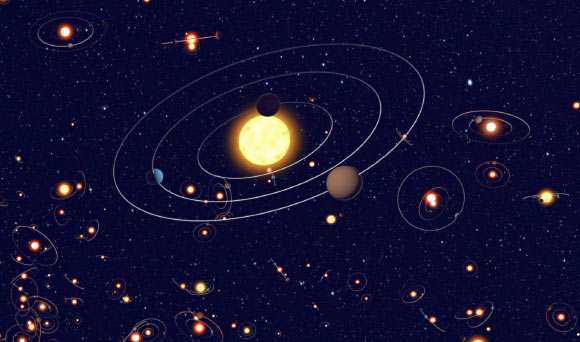Astronomers using data from NASA’s extended Kepler mission, known as K2, have discovered 95 new exoplanets, with sizes ranging from mostly rocky super-Earths and fluffy mini-Neptunes to Jupiter-like gaseous giants.
NASA’s Kepler Space Telescope discovers new extrasolar planets by measuring the subtle dip in a host star’s brightness caused by a planet passing in front of the star.
In its initial mission, Kepler surveyed just one patch of sky in the northern hemisphere, determining the frequency of planets whose size and temperature might be similar to Earth orbiting Sun-like stars.
In the spacecraft’s extended mission in 2013, it lost its ability to precisely stare at its original target area, but a brilliant fix created a second life for the telescope that is proving scientifically fruitful.
After the fix, Kepler started its K2 mission, which has provided an ecliptic field of view with greater opportunities for Earth-based observatories in both the northern and southern hemispheres. Additionally, the K2 mission is entirely community-driven with all targets proposed by the scientific community.
Because it covers more of the sky, the K2 mission is capable of observing a larger fraction of cooler, smaller, red-dwarf type stars, and because such stars are much more common in the Milky Way than Sun-like stars, nearby stars will predominantly be red dwarfs.
“Exoplanets are a very exciting field of space science. As more planets are discovered, astronomers will develop a much better picture of the nature of exoplanets which in turn will allow us to place our own Solar System into a galactic context,” said Andrew Mayo, Ph.D. student at the National Space Institute at the Technical University of Denmark.
Mayo and co-authors analyzed hundreds of signals of potential exoplanets thoroughly to determine which signals were created by exoplanets and which were caused by other sources.
“We started out analyzing 275 candidates of which 149 were validated as real exoplanets. In turn 95 of these planets have proved to be new discoveries,” Mayo said.
“This research has been underway since the first K2 data release in 2014.”
“We found that some of the signals were caused by multiple star systems or noise from the spacecraft. But we also detected planets that range from sub Earth-sized to the size of Jupiter and larger,” he added.
One of the planets detected by the astronomers was orbiting a very bright star.
“We validated a planet on a 10-day orbit around a star called HD 212657, which is now the brightest star found by either the Kepler or K2 missions to host a validated planet,” Mayo said.
“Planets around bright stars are important because astronomers can learn a lot about them from ground-based observatories.”
The discoveries will be published in the Astronomical Journal.
Source: Sci News

































Leave a Comment
You must be logged in to post a comment.